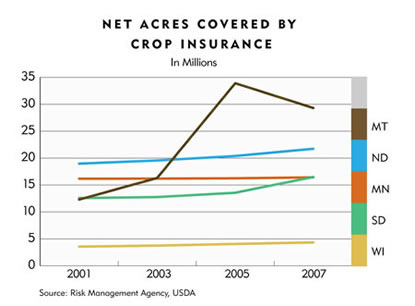As the financial stakes in farming rise ever higher, one way to gauge risk is to look at the safety net that farmers install beneath themselves. Two financial tools exist to help farmers mitigate risk—crop insurance and forward contracting—and trends in each suggest that they are being employed more often.
In district states the number of acres covered by crop insurance increased from 63 million in 2001 to 88 million in 2007. Most of that gain came in Montana (see chart), though South Dakota and Wisconsin saw covered acres rise 31 percent and 22 percent, respectively. Use of crop insurance has historically been high in North Dakota, yet the state still saw covered acres increase 15 percent. Only Minnesota saw virtually no change (1.5 percent).

The reasons for this increase are twofold: With high commodity prices, farmers can afford to buy more crop insurance; equally important, high input costs virtually require insurance to ensure some revenue for every acre, regardless of its source. And because indemnities are tied to commodity prices (along with average yield), insurance compensates losses at comparatively generous levels.
Although commodity prices are high now, many believe they won't stay high for long. One way for farmers to guard against volatile swings in prices is to forward contract their harvest. In essence, this is a promise to deliver a certain amount of crop at a specified price, regardless of what happens to prices in the meantime.
In general, the use of forward contracting has been growing; the value of ag production covered by forward contracts rose from 28 percent in 1991 to 41 percent in 2005, according to a report this past April by James MacDonald of the U.S. Department of Agriculture's Economic Research Service. Because of a time lag in conducting the nationwide survey and aggregating and analyzing results, the ERS doesn't know exactly how things have changed since the onset of strong commodity prices.
It's widely believed that forward contracting has gained wider acceptance among farmers and ranchers. If so, that would be a good sign of prudent financial planning. But the penetration of forward contracting runs much deeper in certain livestock markets that have become vertically integrated—like hogs and poultry, which are both strong in some district states. Growers of major field crops like wheat, corn and soybeans use forward contracting comparatively less; such contracts are usually shorter in duration (usually a single growing season) and, unlike livestock operators, farmers typically have little relationship with the contractor.
MacDonald noted via e-mail that the 2006 survey—not yet publicly released—showed an increase in marketing contracts among major field crops. For example, marketing contracts covered 25 percent of the value of corn production, a significant rise from a 16 percent average between 2002 and 2004; soybean contracts covered 16 percent of value (compared to 12 percent earlier) and wheat contracts rose to 14 percent (from 8 percent). These figures also do not take into account significant amounts that are consumed by a farmer's own livestock, rather than sold to the market.
Despite being able to lock in solid prices, many farmers still do not forward contract, in part because they've seen other farmers get even higher prices later in the year—which was often the case for those who contracted early in 2007. The steady rise in input costs is giving some a rationale to roll the dice, hoping for still higher prices later in the year.
Kelly Cape, head of the Day County (S.D.) Farm Service Agency, said that a majority of clients do at least some forward contracting. But the rate is even higher—upward of 80 percent—among established operators with good equity.
Smaller operators "are generally more conservative and are not familiar with the process," said Cape, via e-mail. Forward contracting "is something new that they have not taken the time to understand. … Most of them agree that they need to do something. [The hard part] is just getting them to do it."
Ron Wirtz is a Minneapolis Fed regional outreach director. Ron tracks current business conditions, with a focus on employment and wages, construction, real estate, consumer spending, and tourism. In this role, he networks with businesses in the Bank’s six-state region and gives frequent speeches on economic conditions. Follow him on Twitter @RonWirtz.





